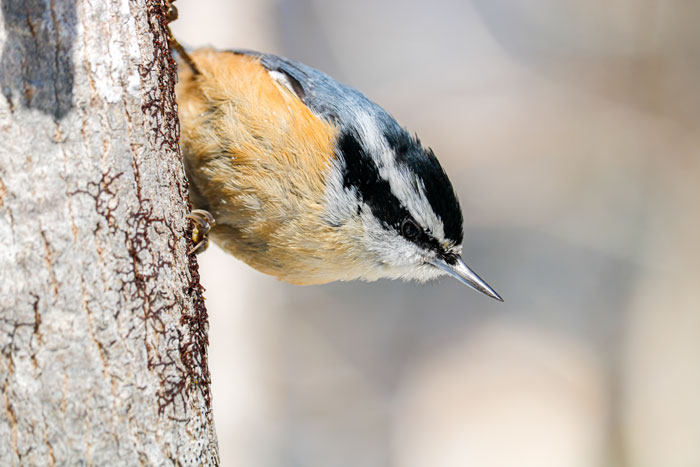
Before moving to Maine, I had never seen a red-breasted nuthatch. I was quite familiar with white-breasted nuthatches, as they had always come to my feeders when I lived elsewhere. To say the least, I was quite excited when I spotted my first red-breasted nuthatch at my feeders. With little fear of humans, I also found it fascinating how approachable these birds are. Often, while I am refilling the feeders, these curious birds would not be bothered by my presence and go about with their feeding. It is quite also common to both see and hear them in the woods as well. These birds are also quite vocal and how I do appreciate their unique nasal honking calls.
Last fall, I met one of our resident males. While I was hand-feeding the black-capped chickadees, he introduced himself to me. He was a little hesitant with hand-feeding, so I would offer my hand with food to him while he was still perching on branches. Eventually, he came down and started eating from my hand and he was no longer shy about asking for food. He is quite a character and I looked forward to our daily meetings. I especially like his appearance. I always know it’s him because of how his distinctive head feathers stick up a little bit, making him look like he’s always having a perpetual bad hair day!
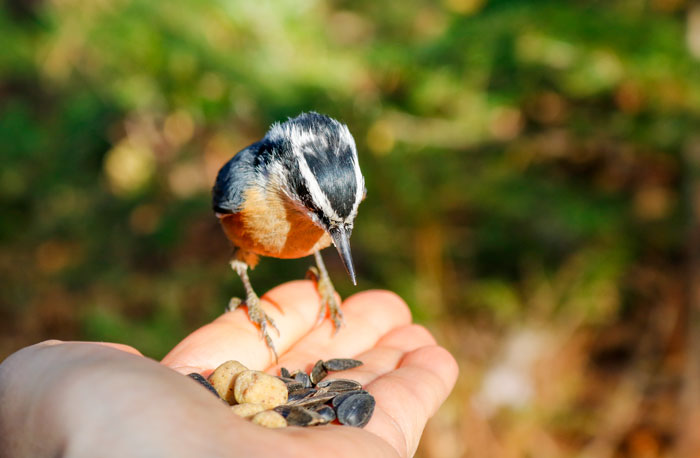
As the months passed and winter came, we were joined by a female. She introduced herself to me by perching on the top of my head. She was definitely more forward than the male from the beginning and she fit right into our daily feeding routine with the rest of the gang consisting of the male red-breasted nuthatch,black-capped chickadees, and white-breasted nuthatches.
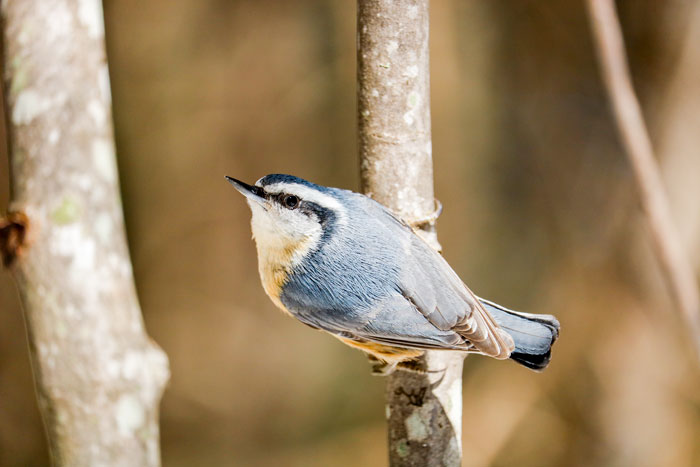
Now that it is spring, these two nuthatches have had other priorities as they are getting ready for breeding season and nesting. I could tell our hand-feeding sessions would become fewer. They had started coming to visit me together quite often and I’m sure they will become a breeding pair. As the weather became warmer, they were no longer coming to visit me in the woods for our daily hand-feeding sessions. If they stay in the area, I suppose I will see them again this fall, and perhaps we will resume our hand-feeding activities. Perhaps they will bring their young with them, too.
Here are a few photographs that I have taken of these that one could only describe as quirky birds as well as some information and details of their behavior. I hope you enjoy reading.
Nuthatches come in two varieties here in Maine: white-breasted and red-breasted. They are both frequent visitors to bird feeders, with a preference for nut-like food. If you’re unfamiliar with these two types of nuthatches, you may at first think you’re looking at the same bird. Nuthatches are known as “upside-down birds,” climbing just as easily down the bark of a tree as up it.
Red-breasted Nuthatches vs. White-breasted Nuthatches
Red-breasted nuthatches Sitta canadensis) are smaller and stubbier than the white-breasted nuthatch and get their name from the blush of red on the chest. The white-breasted nuthatch Sitta carolinensis has a black hood without an eye streak.
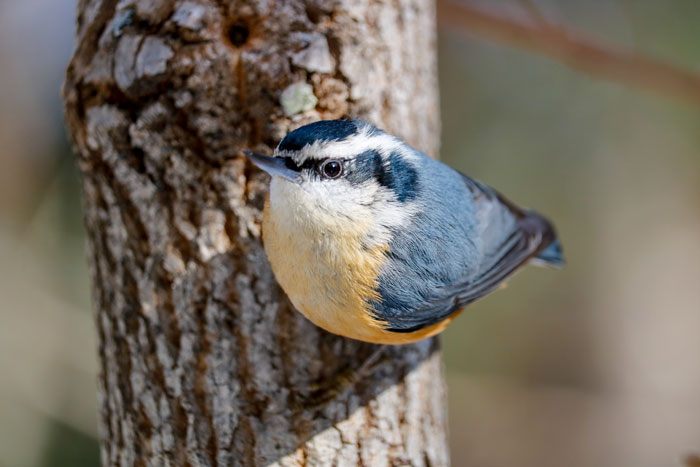

Description of the Red-breasted Nuthatch
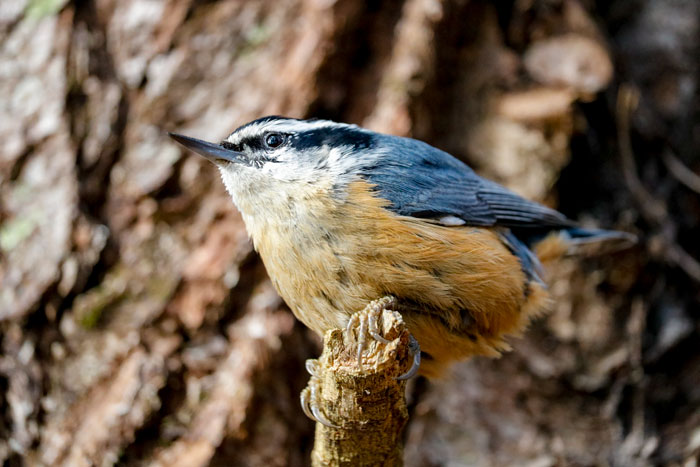
Red-breasted nuthatches are small, compact birds with a sharp expression accentuated by a long, pointed bill. They have very short tails and almost no neck; their bodies are plump or barrel-chested, and their wings are short and very broad.
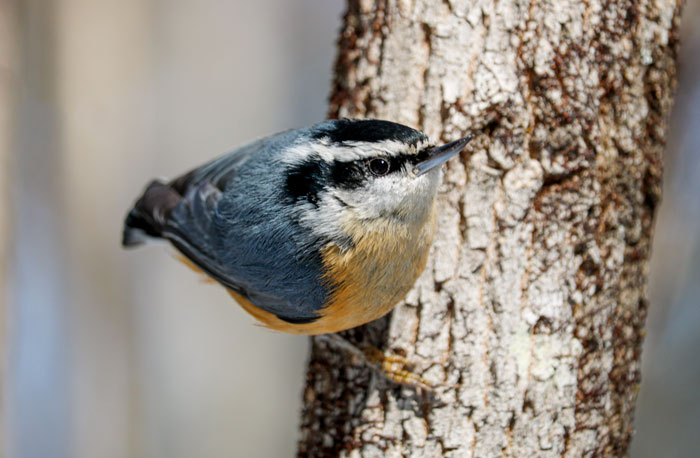
A male red-breasted nuthatch
These birds are blue-gray in color with strongly patterned heads: a black cap and stripe through the eye broken up by a white stripe over the eye. The underparts are rich rusty-cinnamon color. The sexes are similarly plumaged, though females and juveniles have duller heads and paler underparts.
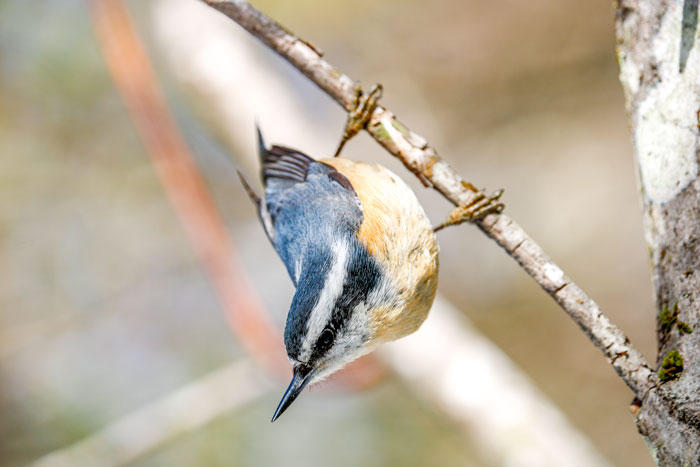
A female red-breasted nuthatch
Red-breasted Nuthatch Behavior
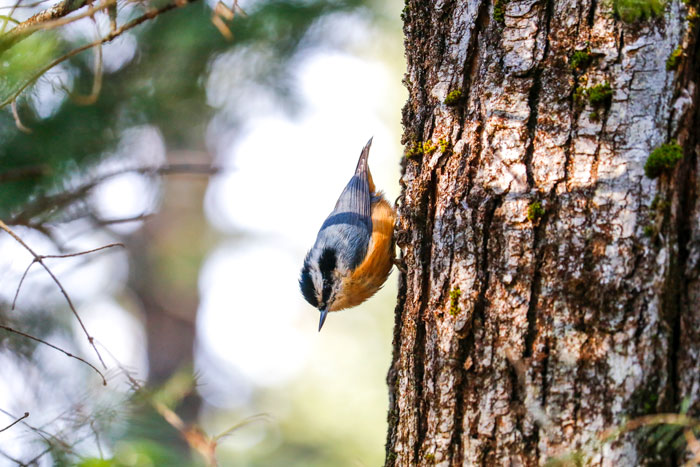
Red-breasted nuthatches are acrobatic birds that move quickly over tree trunks and branches while probing for food in crevices and under flakes of bark. They will creep in every direction without regard for which way is up. These birds move headfirst when climbing down. They can also “walk” on the underside of branches. Unlike woodpeckers and creepers, it does not use its tail as a prop while climbing. Their flight can be described as short and bouncy.
Red-breasted Nuthatch Diet
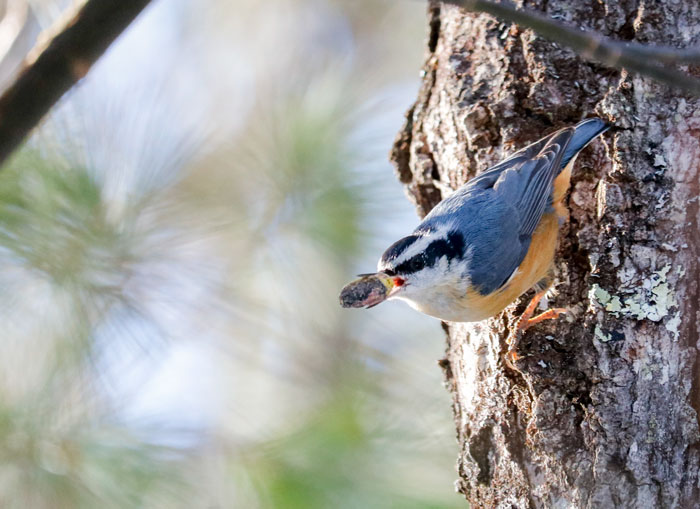
The red-breasted nuthatch’s diet will change depending on the season. During the summer, they eat mostly insects, occasionally even flycatching. In the winter, they switch to conifer seeds. At feeders, they enjoy peanuts, sunflower seeds, peanut butter, and suet. They often wedge food pieces in bark crevices in order to break them up with their bills. If given the choice they tend to select the heaviest food item available; if these are too large to eat in one piece they will typically jam them into the bark and then hammer them open to consume.

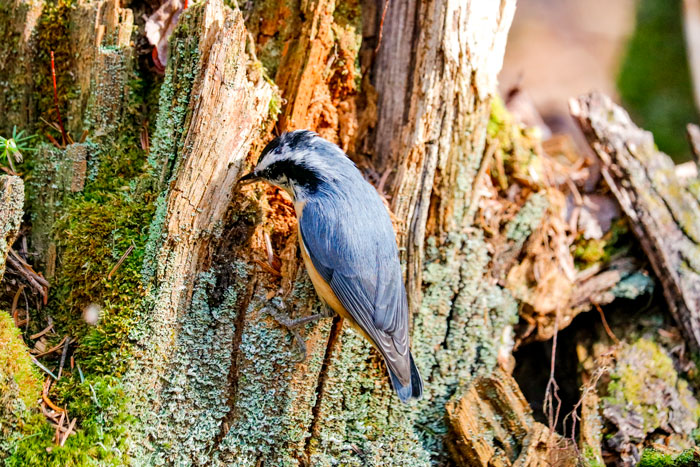
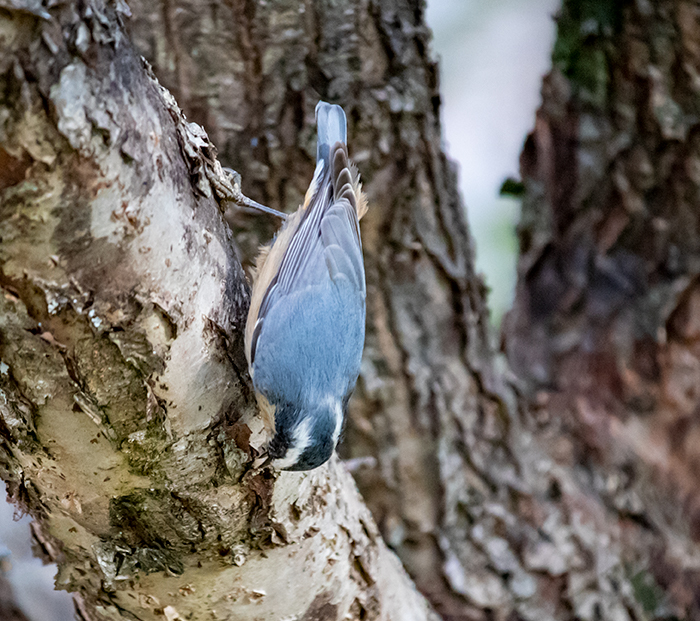
Similar to other nuthatches, red-breasted nuthatches also practice caching, meaning they store food to consume at a later time. They often store hundreds of seeds, one at a time, under the loose bark of a tree, typically hiding their cache with a piece of bark, lichen, moss, or snow. As winter sets in, they will eat fewer insects and more nuts and seeds, including their cached reserves.
Red-breasted Nuthatch Habitat
Red-breasted nuthatches favor coniferous trees for breeding but use a wide variety of wooded habitats at other times of the year. They can be found among spruce, fir, pine, hemlock, larch, and western red cedar as well as around aspens and poplars. In northeastern North America, you can also find them in forests with varieties of oak, hickory, maple, birch, and other deciduous trees.
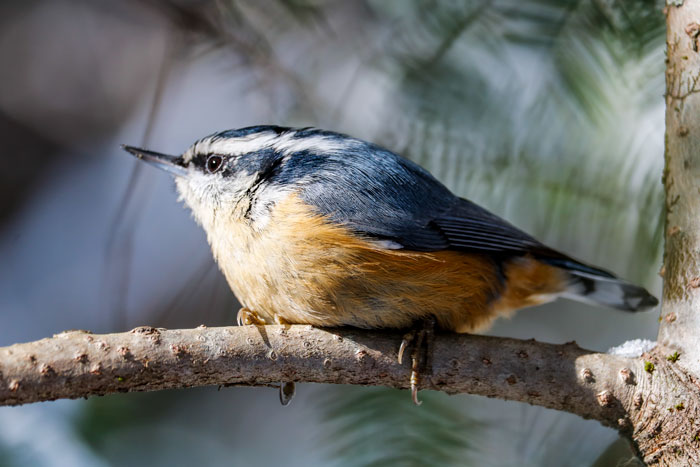
Red-breasted Nuthatch Songs & Calls
From personal experience with these birds, I have to say they are quite vocal, using an assortment of whistles, trills, and calls. While I’m in the woods, I often hear them before I see them coming. They have so much energy and it is amusing to see them interact with each other as well as with me. I swear they enjoy hearing themselves talk.
The song of the red-breasted nuthatches is a fast, clear series of monotonous nasal rising calls, that are hornlike notes sounding like yank-yank. Their songs can have six or more of these notes each, and the songs themselves can be repeated up to sixteen times per minute. Unmated males sing this most frequently. Males and females sometimes sing a similar but slower and harsher version of this song when they are defending their territory.
The yank note can also be given as a call by both sexes (though more often by the male) as a way of communicating between the pair. This note can be sped up until it sounds like a vibrating trill, usually given from near the nest just at the end of nest excavation or beginning of egg-laying. During confrontations, chases, or copulation, nuthatches may make a phew call and agitated birds sometimes make a wren-like scolding call.
Red-breasted Nuthatch Breeding & Nesting
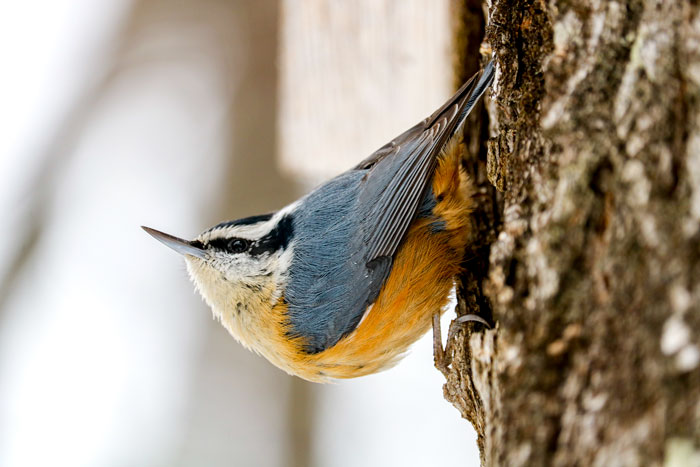
Unlike other nuthatches, red-breasted nuthatches have a softer musical song, used especially in courtship by males. In the courtship display, the male turns his back toward the female, raises his head, droops his wings, and sways from side to side. The male also feeds the female during courtship. Both sexes excavate a nest cavity in rotten stub or snag, usually five to forty feet above the ground, rarely much higher. They will rarely use old woodpecker holes or birdhouses. They also smear a sticky pitch around the entrance to the nest hole; this may el to deter predators from entering the nest cavity. Adults avoid getting stuck in pitch by flying straight into the hole. The female does most of the nest building. The nest inside of the cavity consists of soft grass, moss, bark fibers, and feathers.
The clutch size is two to eight eggs. They are white and spotted with reddish-brown. Females incubate the eggs and males bring food to females on and off the nest. The incubation period lasts for about twelve days. Both parents feed nestlings and the young leave the nest about two to three weeks after hatching. Both parents feed the nestlings; the young leave the nest about two to three weeks after hatching. They have one brood per year.
Red-breasted Nuthatch Migration
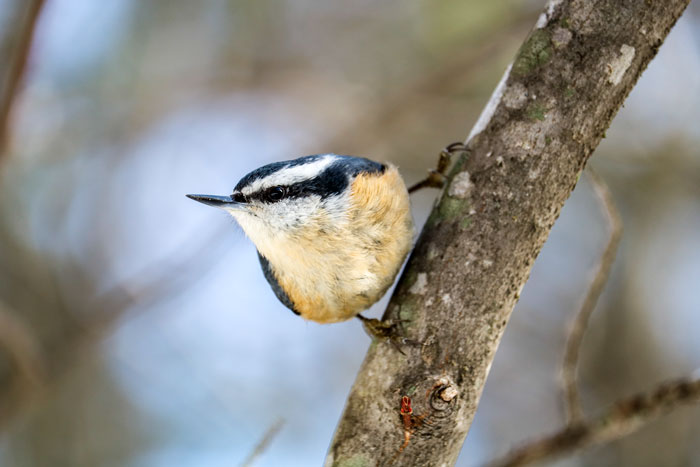
The red-breasted nuthatch is considered to be a resident, short-distance migrant, or irruptive species. Northernmost populations may migrate south each year, but other populations may not migrate at all. These birds can be irruptive, moving southward in great numbers in years when cone production is scarce on their breeding grounds. This happens on a roughly two-year cycle, and in some years red-breasted nuthatches may show up as far south as the Gulf Coast.
How to Attract Red-breasted Nuthatches
If you would like to attract these feisty birds to your yard, you can offer them a few of their favorite treats. Some of the red-breasted nuthatches’ favorite foods include shelled and unsalted peanuts, nuts, cracked corn, and a variety of suet. Nuts and peanuts can be offered in mesh feeders as well as stackable or cylinder feeders
Red-breasted nuthatches are extremely approachable birds and have been known to take food from an extended hand. As an added bonus, other birds such as black-capped chickadees and titmice will also join in and take advantage of this activity. I have had great success with offering Feathered Friend Chickadee’s Choice. This food includes a nice blend of sunflower kernels, tree nut pieces, peanuts, black oil sunflower, grey-striped(F sunflower, and safflower. This food can be used in a variety of feeders and works wonderfully for hand feeding, too!

I can’t wait for this fall, as the red-breasted nuthatches will once again be interested in hand-feeding. I’ll have to make sure I stock up on all of their favorite foods. Until then, I’ll continue to enjoy watching these uniquely entertaining birds at my feeders.
Resources used for this post:
allaboutbirds.org & audubon.org
Beautiful pictures and so much interesting information. I will be on the lookout for them now !
Thank you, Soraya! I’m glad you enjoyed reading about these interesting birds.
I, too, have been hand-feeding RB nuthatches the last few weeks (along with a number of chickadees, and occasionally a tufted titmouse). One particular male will commonly land on my hand, take a sunflower seed, and then climb all over me looking for a place to stash it. His record is 12 seeds stashed up my sleeves, wrinkles in my jacket, and he even tapped one in place behind my ear, before taking a seed a flying off. I have found that his favorite food is peanut halves. I keep a few in my right hand and he will sort through the miscellaneous seeds in my left hand and then land on my right hand a wait for me to open it so he can get a peanut. He’s a smart little guy!
Hi, Rex, Thank you so much for sharing your story! These birds truly are a bunch of characters! Enjoy, Laura